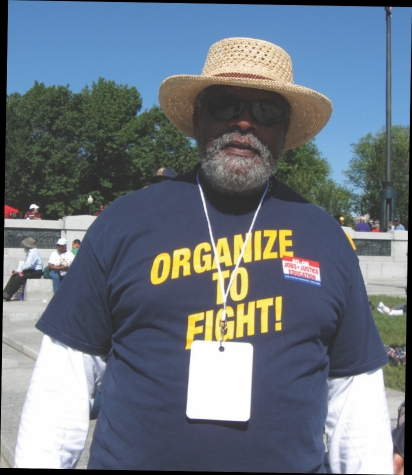
One Nation Working Towards Change
Whitney Adams
 |
| Vera L. Kelly from NAACP and a former AFL-CIO member attended the rally to support President Obama and to fight for solutions to the problems plaguing our nation today. Photo: Whitney Adams |
The One Nation March occurred without a hitch on October 2, 2010, a historical moment for progressives during the Obama administration. The march was the largest progressive rally to be held in Washington DC since the November 2008 election, and with midterm elections around the corner, the stakes were high. Over 400 organizations sponsored this event, primarily unions and civil rights groups representing various interests of Left movements: jobs, war, environment, education, equal rights, immigration, socialism, etc. Estimates put the crowd at almost 200,000 participants, and their purpose was clear: be active, be heard, and affect change.
Syracuse participants comprised a diverse component of the overall march turnout. Members of several local unions, including 1199 Service Employees International Union (SEIU), United Auto Workers, Civil Service Employees Association, and NY Shipping Association, and social justice groups, such as the NAACP and the Syracuse Peace Council, joined community members from local churches and schools to form a convoy of over 500 people busing down to Washington DC. Though Syracuse participants had the event’s many purposes in mind, their main concerns were jobs and unity.
Paco Valle, a retired member of the military from Syracuse, echoes this aspect of the March: “It’s all of us, not just one fringe group or two fringe groups, and all of America is really concerned with the way the country is going.”
Both he and his wife, Sheri, emphasized standing together to fight for the needs of our nation. Sheri also fears the economic situation, especially for her daughter: “I’m very lucky because I am employed, but I am concerned about the state of jobs in Central New York. It’s going to be very difficult for my daughter when she does graduate from college to get a job…jobs are a huge part of making our economy work.”
 |
| Chris Silvera, Secretary-Treasurer of the Teamsters Local 808, focuses on change in jobs, healthcare, and education in order to align our future with past visions for the US. Photo: Whitney Adams |
Sheri’s concerns were echoed by many of the speakers at the Lincoln Memorial. Jesse Jackson’s shouts of “Jobs now! Jobs now!” rang throughout the National Mall as participants clapped and shouted their enthusiasm. Choruses of “Keep hope alive!” followed as Jackson’s call and response rhetoric moved thousands to unite and look toward the future.
Speakers and protesters drew strength and inspiration from the past, remembering the March on Washington led by Martin Luther King, Jr. in 1963. Chris Silvera, the Secretary-Treasurer of Teamsters 808, points out the difference between dreams for the US and our reality today: “As we look at where the youth is today, the youth of America are going to be without a pension, without quality healthcare if things continue the way they are, and without a job. That’s not the America that FDR thought about, that John F. Kennedy thought about, that Johnson thought about, that Martin Luther King Jr. thought about.” Re-visioning our present to fit with our dreams is critical in realizing change for our nation.
Many participants came to the march to show appreciation for what they believe Obama has tried to do: align our country with our dreams. However, that appreciation was often coupled with a desire to see further change in our nation. Vera L. Kelly, a former member of AFL-CIO and an active member of the NAACP, epitomized the desire to both support Obama and push for deeper improvements: “We’re here because we want things to be better, and we’re here to back Barack and what he’s doing.” The March was permeated by this tension between what has been done and what could be done.
Much of the march’s intent has been confused in the media by comparisons to the rally that Glenn Beck led in Washington DC to “restore honor” to our nation. Headlines like, “One Nation Rally Offers ‘Antidote’ to Tea Party” and “Battle of the Rallies: ‘One Nation’ vs. Glenn Beck’s ‘Restoring Honor’” perpetuate the idea that the march was a superficial response to the Beck/Palin rally that brought together Tea Party members. By focusing on turnout and whose rally “won”, these articles depict the One Nation March supporters and Tea Party members as opposing sides, framing the story as one of a nation divided. Yet, the shared spirit of advancement and enthusiasm present at the One Nation rally came from a sense of unity. An inclusive progressive movement has the potential to establish a recognition of diversity so we can work with our differences to create the change we need.